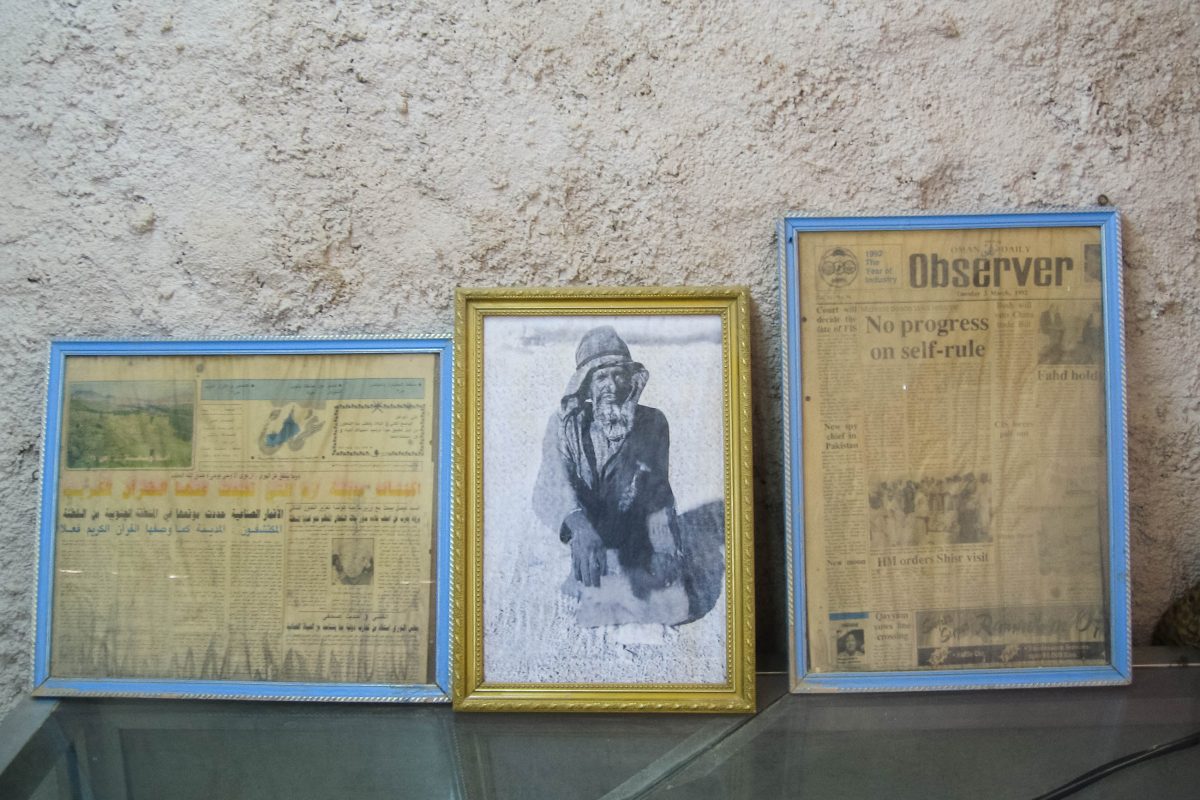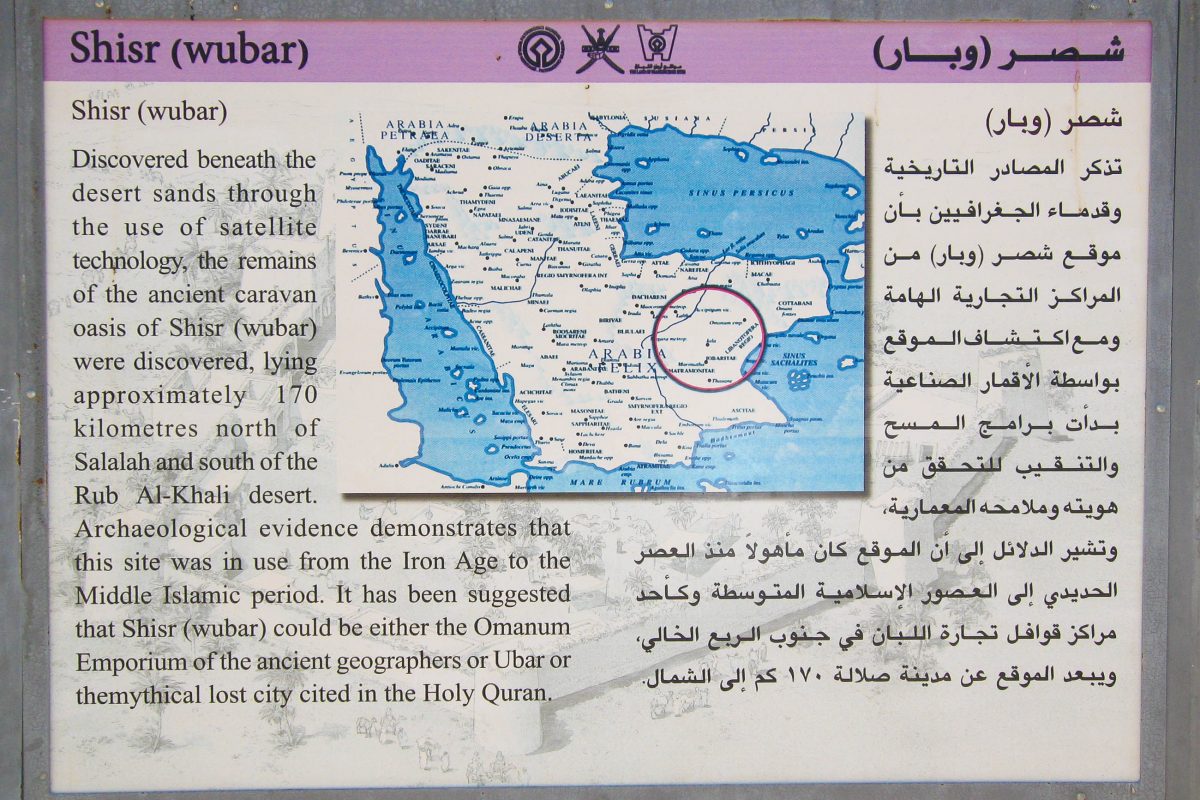Am Rande der Rub al-Khali im Süden des Oman liegt die Ausgrabungsstätte der legendären Handelsstadt Ubar. Ihre prachtvollen Bauten sollen mitsamt ihren Bewohnern laut dem Koran vor 2.000 Jahren von Allah im Sand versenkt worden sein.
Die Stadt Shisr im Süden des Oman liegt in der Nähe der Stadt Salalah, hinter der Rub al-Khali, der größten Sandwüste der Welt. Sie wird von zahlreichen Legenden umrankt. Die berühmteste tituliert Shisr als die sagenumwobene Stadt Ubar, die spätestens seit dem Buch des britischen Abenteurers und Entdeckers Ranulph Fiennes „Atlantis of the Sands“ weltweit bekannt ist.
Unter der Bezeichnung „Land of Frankincense“ („Land des Weihrauchs“) zählt Shisr gemeinsam mit anderen Stätten an der Weihrauchstraße zum Weltkulturerbe der UNESCO. Ubar war als Kreuzungspunkt von Karawanenwegen einst eine wichtige Stadt, die es durch den Handel mit Weihrauch, Gewürzen, Kupfern und vermutlich auch Araberpferden zu großem Reichtum brachte. Sogar die Königin von Saba soll hier gewesen sein, um Weihrauch zu kaufen.
Ubar wird in der Bibel und im Koran erwähnt und als prachtvolle Stadt mit vielen Säulen beschrieben. Auch der griechische Geograf und Astronom Claudius Ptolemäus und der arabische Historiker Mohammad Al Hassan Al Hamdani berichteten in ihren Schriften vom sagenhaften Ubar. Trotz aufwändiger Suche konnte die legendäre Stadt jedoch lange nicht lokalisiert werden.
Inhaltsverzeichnis
Entdeckung von Ubar

Den ersten konkreten Hinweis, wo sich Ubar befinden könnte, erhielt der Brite Bertram Thomas, der im Jahr 1932 die Rub al-Khali durchquerte. Damals informierte ihn einer seiner arabischen Begleiter, dass hier die Straße nach Ubar verlaufe. Er vermerkte dies zwar in seinem Reisebericht „Arabia felix“ („glückliches Arabien“), ging der Sache jedoch nicht weiter nach.
Den nächsten Hinweis lieferte erst viele Jahre später das Radar der NASA-Raumfähre Challenger, das unter dem Sand eine 100km lange Straße am Rand der Rub al-Khali entdeckte. Die alten Karawanenwege waren gefunden, doch von einer glorreichen Stadt nach wie vor keine Spur.
Schließlich machte sich im Jahr 1990 ein Forscherteam von der Southwest Missouri State University auf, Ubar endlich auszugraben, mit dabei waren der Spezialist für arabische Archäologie Dr. Yuris Zarin, Nicholas Clapp, ein US-amerikanischer Schriftsteller, Filmemacher und Hobby-Archäologe, der oft als der „echte Indiana Jones“ bezeichnet wird, und der britische Abenteurer Sir Ranulph Fiennes.
Und tatsächlich entdeckte das Team 1992 mit Hilfe der NASA-Bilder und den Aufzeichnungen von Thomas eine Karawanserei mit einer Quelle, damals die letzte Station vor der scheinbar unendlichen Sandwüste.
Die Stadt war scheinbar durch eine Absenkung des Bodens im wahrsten Sinn des Wortes vom Erdboden verschluckt worden. Einige der Gebäude wurden auf das dritte Jahrtausend vor Christus datiert. Die Suche nach Ubar und seine atemberaubende Entdeckung hielt Sir Ranulph Fiennes in seinem Buch „Atlantis of the Sands – The Search for the lost City of Ubar“ fest und machte die historische Stätte damit weltberühmt.
Besichtigung von Shisr/Ubar

Nach Shisr gelangt man über die Stadt Thumrayt, nach 16km biegt eine landschaftlich langweilige Piste Richtung Westen ab, auf der es noch einmal 75km bis nach Shisr geht.
Tipp: In Thumrayt unbedingt noch einmal den Tank auffüllen, denn auf der Weiterfahrt Richtung Wüste ist keine Tankstelle zu finden.
Das moderne Shisr begrüßt seine Besucher mit zwei schneeweißen Rundtürmen und präsentiert sich dahinter in einer Reihe von unspektakulären einstöckigen Häusern, deren gut 150 Bewohner von der (wieder)entdeckten Quelle versorgt werden.
Unwillkürlich kommen Zweifel hoch, ob man sich hier tatsächlich in Ubar befindet, soll doch laut dem Koran „derengleichen nie im ganzen Land gebaut worden sein“. Hinter einem Hain aus Dattelpalmen findet man eingezäunt die Ausgrabungsstätte der legendären Stadt.
Ausgrabungsstätte von Ubar

Die archäologische Stätte des verlorenen Ubar ist leider wenig eindrucksvoll. Bis auf einige Steinhaufen im Wüstensand und einen gewaltigen Spalt im Boden gibt es wenig zu sehen. Es wurden zwar Scherben aus China, Rom und Ägypten gefunden, doch nichts deutet auf eine Stadt im beschriebenen Ausmaß hin.
Dennoch sind sich Yuris Zarin und sein Team sicher, Ubar gefunden zu haben. Denn der Koran berichtet, dass Allah Ubar aufgrund des verschwenderischen und sündhaften Lebensstils seiner Bewohner im Sand verschwinden ließ. Und tatsächlich liegt mitten in der Ausgrabungsstätte ein 12 Meter tiefer Krater, der um etwa 500 nach Christus entstanden ist.
Es kann jeder für sich entscheiden, ob sich ein Abstecher zum „Atlantis der Wüste“ auszahlt. Für Fans von Mythen und Legenden hat ein Spaziergang durch das legendäre Ubar bestimmt einen ganz besonderen Reiz.





